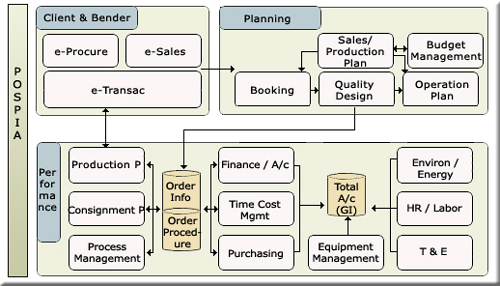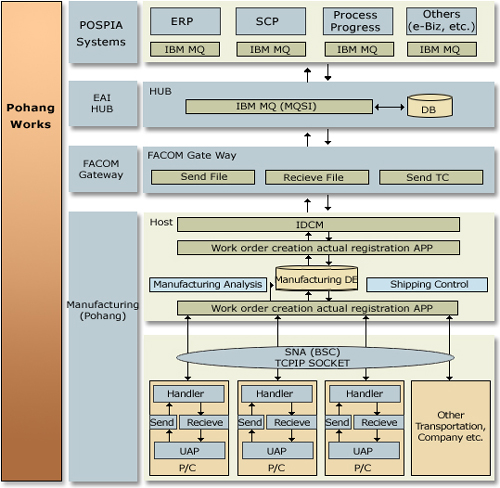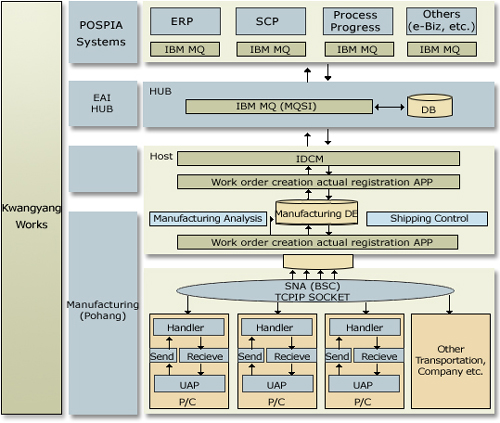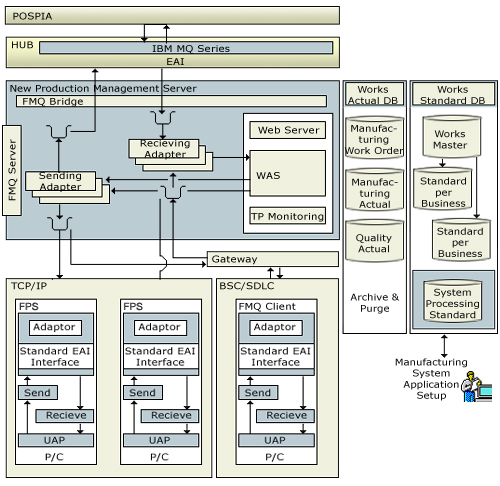Manufacturing – POSCO
 Download PDF
Download PDF
Posco optimizes manufacturing processes and achieves real-time competencies with the Fiorano Business Integration Solution

Customer Profile
Steel manufacturing is one of the most complex processes. POSCO is leveraging the power of technology to simplify its Steel manufacturing processes and business related tasks such as connecting the manufacturing systems to its digital management system called POSPIA. POSPIA consists of POSCO's e-Sales and e-Purchasing and across the company's value chain over the Web. To help make this happen, the company selected Fiorano Enterprise Service Bus™ (Fiorano ESB) as its Integration Platform for flexible integration and Business Process Automation Capabilities. With Fiorano ESB, POSCO is successfully streamlining and automating internal processes company-wide and also web enabling many of its operational support systems, improving service to its customers in the competitive Steel Manufacturing marketplace.
Company Overview
Established in 1968, Korea-based POSCO is the world's largest steel manufacturer. With an annual crude steel production capacity of 28 million tons and annual revenues of $US8.6b, POSCO is considered by Morgan Stanley to be the most sustainable company in the steel industry. The company makes hot- and cold-rolled steel products, which it sells to the auto and ship building industries. Subsidiaries also include POSCO Engineering and Construction and POSDATA.
Business Problem
POSCO is aggressively driving the transformation of Steel Manufacturing processes to standardize the operation systems at each Steel mill. This would lead to an increase in cost benefits by minimizing redundancy in data and program management. POSCO's Business and technical drivers can be summarized as follows:
- Currently POSCO's IT infrastructure consists of 600 computers of different hardware, different Operating Systems. Some of these PCs communicate over BSC protocols while others over the TCP/IP protocol, resulting in setting up of two parallel networks with little scope of communication between these PCs.
- Additionally, these computers are spread across various geographical locations in South Korea - at Seoul, Pohang and KwangYang. The existing point-to-point interfaces between various applications at the various Steel Works make monitoring, maintenance and new application development extremely difficult and time consuming.
- The current IT infrastructure is a very closed system that is resistant to any changes in hardware or software configuration. This results in extremely high maintenance and upgrade costs.
- Currently, POSCO manually monitors all the Process Computer's at its various Steel Mills. POSCO currently needs a team of 15 engineers at each of its site, manually monitoring all Process Computers for faults. Average time between problem occurrence and its detection is quite high (approximately 4 hours).
- Data exchange between a Process Computer (P/C) and a Business Computer (B/C) is not over a reliable link. Moreover, the only Backup and Recovery System (BRS) is a complex process of analyzing logs at each of the PC's and comparing with that of a B/C to manually detect differences. All logs are stored at network endpoints and at times these could be more than 200 miles from the place of detection of problem. The current system provides almost no support for remote access of logs and events for remote debugging.
- POSCO currently has no disaster recovery system implemented across the all Steel Works. In case the Business Computer at KwangYang goes down, there is no process in place to ensure that the Business Computer at Pohang takes control of all the PC's. This switch has to be made manually at each of the 200 P/Cs that are distributed at different geographical locations across South Korea.
Current Architecture Topology
POSCO's current IT infrastructure consists of three major components:
POSPIA at Seoul
POSCO's core digital management system is called POSPIA. The POSPIA system is located in Seoul (Boon-dang data center). It is composed of ERP (Enterprise Resource Planning), SCP (Supply Chain Planning), Data Warehousing, and other Enterprise systems. The ERP system takes care of Order Entry, Mill Allotment, ATP Check, and Progress Management. The SCP takes care of Process Plan, Progress Management and Production Management. The SCP also performs Sales and Production Plan, Order Management, Quality Design, Shipment Distribution, and Cost Management.

Figure 1 : POSPIA Data Flow
Pohang Works
A Fujitsu FACOM mainframe is used to house the current Production Management Host (Business Computer or B/C) at Pohang. There is one online machine and one hot standby backup. The Host controls steel manufacturing processes and it also serves as the focal point for other computers (Process Computers and distributed servers) to transmit and receive data to and from the POSPIA.
The FACOM Host provides connection interfaces in FNA (BSC/HDLC) and TCP/IP mode. Pieces of equipment connected to the Host in FNA are P/Cs (65 in number), handy, and terminals. Pieces of equipment communicate with the Host in TCP/IP are P/Cs (136 in number), Label Printer servers (11 in number), distributed servers (37 in number), and personal computers.

Figure 2 : Current Systems at Pohang Works
KwangYang Works
An IBM mainframe is used to house the current Production Management Host (B/C) at Kwangyang. There is one online machine and one hot standby backup. The Host controls steel manufacturing processes and it also serves as the focal point for other computers (Process Computers and distributed servers) to transmit and receive data to and from the POSPIA.
The IBM Host provides connection interfaces in SNA (BSC/SDLC) and TCP/IP mode. Pieces of equipment connected to the Host in SNA are Process Computers (P/Cs - 57 in number), handy, and terminals. Pieces of equipment communicate with the Host in TCP/IP are P/Cs (184 in number), Label Printers (53 in number), distributed servers (15 in number), and personal computers (110 in number).

Figure 3 : Current Systems at Kwangyang Works
The existing topology includes a number of disparate platforms and applications described in the table below:
| Steel Works | Hardware | OS | Protocol |
| Pohang | Fujitsu FACOM | MSP/EX | BSC, TCP/IP, HDLC |
| Super Dome | Info. Not required | TCP/IP | |
| Hp rp8400 | HP-UX 11.11i | TCP/IP | |
| HP rp7410 | HP-UX 11.11i | TCP/IP | |
| Kwangyang | IBM Mainframe | OS390 V2.7 | BSC, TCP/IP, HDLC |
| Super Dome | Info. Not required | TCP/IP | |
| HP rp8400 | HP-UX 11.11i | TCP/IP | |
| HP rp7410 | HP-UX 11.11i | TCP/IP |
It was becoming increasingly difficult for POSCO to exchange data between these legacy applications and other new systems and applications due to different protocols.
System Requirements
The POSCO Architecture group had been asked to design a new system that will resolve the current business and technical problems and also provide the flexibility to adapt to emerging market requirements. The Architecture team came up with the following requirements for the new system:
- Integration of Applications Running on Disparate Hardware and Operating Systems
POSCO's IT infrastructure is spread over 400 miles with 600 computers of varied hardware, OS and even communication protocols. 200 PC's (Process Computers) are spread over Pohang & KwangYang - getting live information from steel manufacturing machines. With the new infrastructure all these PCs need to send real-time information to BC (Business Computer), which is an IBM Mainframe. - Improvement in Quality and Operational processes
POSCO officially launched its Six Sigma campaign by holding the 'Six Sigma First Wave Launch Ceremony' on May 2 2002. Through the Six Sigma campaign, it plans to statistically and scientifically maximize company work quality by basing the endeavor on the infrastructure that was established in the first phase of PI. Providing appropriate information to perform Six Sigma tasks was difficult as there were overlaps of data among systems and the quality and operation analysis data was not accurate. In addition to this, Complex data makes performing quality analysis difficult. For achieving this objective, establishing unified web-based open operation systems on top of the new infrastructure becomes highly important for POSCO. - Open Systems Architecture
The new infrastructure should also help POSCO move towards more "open-systems" to be able to realize full benefits of new technologies. - Management of Different Data Formats
The POSPIA and POSCO's Shop Floor Systems consist of approximately 20 types of system platforms. Currently, there are about 110 servers with various Operating Systems and Databases. Business Information is stored in various formats. For instance, Casting know-how standards are managed in logic and file format at Pohang and logic and in a table format at Kwangyang. Cold Rolling inspection standards reside in file and logic format at Pohang and logic in table format at Cold Rolling Processes at Kwangyang. The new system needed to facilitate information sharing across such systems. - Automation of Business Processes Spanning Geographical Boundaries
POSCO's has multiple Mill locations in Pohang, Kwangyang and Seoul where Steel is produced. The existing system consists of an IBM host Business Computer each at Kwangyang and Pohang. The Programmable Logic Controllers at the shop floor, monitor the manufacturing processes and are connected to the Process Computers which includes legacy systems like Melco from Mitsubishi, Hitachi machines etc and more modern computers. For instance, POSCO's Rolling sequence change process takes place in Hot Rolling department at Pohang and in Process Shipping department (under Production Control) in Kwangyang. The new system infrastructure should have the ability to transfer data at real-time from one location to other in a secure manner. - Real-time Administration and Monitoring of Applications
Whenever an error occurs, it is currently very difficult to quickly identify where that error has occurred and correct it. Again, the lack of flexibility of the current infrastructure generates delays and thus lost revenues. In case of failure, numerous manual control and re-transmission processes have to be actioned within and between each application. - Integration of Legacy Systems with Best-of-breed New Applications
The Programmable Logic Controllers (PLC's) at the shop floor monitor the manufacturing processes are connected to the Process Computers that includes legacy systems like Melco from Mitsubishi, Hitachi machines, which do not support TCP/IP. Instead they use other legacy protocols like BSC, HDLC and SDLC. - Respond to Business Changes Quickly and More Efficiently
The existing point-to-point interfaces between various Applications at Steel Works make maintenance and new developments difficult and time consuming. The complexity, unmanageability and cost of point-to-point application integration are huge. POSCO was looking for an EAI Platform that could provide capabilities of faster responsiveness to Business Process Changes. For Example in POSCO's Sales Automation System there is an attribute called 'initial cost'. The default value is 1,000won until May 31, 2002 23:59:59 and the default value will be changed to 10,000won from June 1, 2002 00:00:00. Then the user should be able to set the condition so that existing adapter will take care of data up to timestamp of May 31, 2002 23:59:59 and start a new adapter with the change at the set time (June 1, 2002 00:00:00) so that messages received after the set time will be processed by the new adapter. - Implementation of a Disaster Recovery System
Implementing a Disaster Recovery System, as a part of the new architecture is a major step towards ensuring continuous manufacturing and to ensure continuous data flow and monitoring. Given the high volume of information to process every day, each flow has a very specific schedule time for processing, requiring high availability of the whole integration infrastructure. If a process is delayed by more than 15 minutes, the entire information chain is delayed, generating delays in delivery of orders and thus lost sales for POSCO. - Integration with Partner Applications
POSCO partners with many companies in order to run its business efficiently. Those companies include raw material providers, finished steel product manufacturers, transportation providers, etc. Most of POSCO's partners companies were running Applications and platforms that were different than the ones being used for managing POSCO's internal processes. The new system is envisaged to provide real-time connectivity between these Applications for having full visibility of all transactions that flow between them.
Solution
After researching possible solutions to satisfy the requirements, the POSCO Architecture Group recommended implementing Fiorano ESB to provide a service-based architecture connecting the varied as software and hardware platforms as mentioned above. Fiorano ESB is a distributed Services Integration Platform that simplifies the composition, deployment, modification and debugging of business processes. Unlike solutions patched together with several point-products, Fiorano ESB is a distributed platform based on the super peer technology with a layered architecture comprising:
- JMS Messaging Server - FioranoMQ
- Fiorano Enterprise Server
- Fiorano Peer Servers
- Management Tools
- Adapters
First and foremost, to tackle the problem of integrating Legacy Systems (with non-TCP/IP) protocol) with the new breed of PC's, a Gateway server was designed to do the conversion from TCP/IP to the B/C protocol that is understood by legacy systems. All the legacy systems were connected with the gateway server that can be connected to any other system such as HP-UX or Windows that understand TCP/IP. Multiple DCP Adapters were installed on the gateway server and each of these have BSC protocol program downloaded in them. These adapters can then talk with the legacy systems.
Fiorano ESB can run on both AIX and Windows machines and the data are sent across to legacy systems through BSC cards. Integration of these legacy systems with the new PC's was the biggest bottleneck that existing infrastructure products (IBM MQSeries, WebSphere Integrator) were not able to provide.
Fiorano ESB defines a new breed of open-ended enterprise integration infrastructure. Fiorano ESB helps links individual enterprises like POSCO, together for extended process efficiency across the supply chain, allowing them more flexibility and adaptability to rapidly changing business requirements. Being a pure java based implementation along with runtime libraries for other languages such as C, C++, Visual Basic makes it run with almost all the systems.
Fiorano ESB also provided POSCO with a comprehensive set of Management and Monitoring Tools. With Fiorano ESB's Business Process Management Capabilities, POSCO's Business and Technical Analysts can now quickly compose, develop, test and deploy Business Processes. In addition, Fiorano ESB's Monitoring and Event Handling Capabilities provided POSCO with Graphical Tools to investigate the origin of the problem and then take corrective action. This not only helped in minimizing the errors but also reduced the delays in problem resolutions. Fiorano ESB provided a centralized system for Real Time monitoring, debugging and administration for the whole system from a remote location.
Fiorano ESB provides multiple File (File Reader, File Writer Adapters) and Database Adapters (Oracle, DB2, SQL Server etc.) to handle a wide range of data and file formats. The Fiorano Pre-Built Adapters extract the Meta Data information from the Source and send the data to the Target Data Source after applying various Business Rules, transformations and validations. Fiorano ESB also comes along with a visual drag and drop tool called the Fiorano Mapper that can be used to map different XML formats. The use of Fiorano Adapters and the Mapping tool helped POSCO save precious time and resources, which would otherwise be required for programming these different complex Business Rules and validations for automating the Manufacturing Business Processes.

Figure 4 : Proposed Systems using Fiorano ESB™
Fiorano ESB provided POSCO with multiple levels of failover support (very important for a disaster recovery system). These are:
- JMS Failover: Multiple JMS bus's can be started on different machines and the Fiorano Enterprise Server (FES) and Fiorano Peer Servers (FPS's) can be configured to connect to these JMS Buses with different order of priority. In case of failure of any of the JMS bus, all the Fiorano servers on the network get automatically connected to the next available JMS bus as per the defined priority. During this migration from one JMS to another, these servers store data, thereby, ensuring no data loss.
- Enterprise Server Failover: Two Enterprise Servers can be started simultaneously to enable hot failover support at the Enterprise level. One of the FES acts as a primary one and the other one as secondary. The Secondary FES keeps a constant vigil and whenever the primary FES gets disconnected from the network, the secondary FES takes over. Till the time the primary FES is up, it keeps synchronizing the secondary FES with the latest information. All the peer servers running on the network will automatically switch to secondary FES in case of primary FES failure.
- Service Level Failover: In an enterprise wide network such as POSCO's, it is quite possible that the Fiorano Peer Server (FPS) goes down or gets disconnected with the network. All the Services running on that particular FPS can then be automatically launched on some alternate FPS, if desired by the user.Fiorano ESB provided POSCO with the ability to dynamically make these changes and synchronize with the existing Business Processes.
Fiorano ESB's component model provided POSCO with a distributed, internet-enabled network and also allows (through the aid of visual tools) the efficient synthesis and deployment of enterprise business processes by programmers and enterprise managers alike, while supporting a high-degree of reusability and flexibility - as summarized below.
| POSCO's Enterprise Users | Benefits with Fiorano ESB™ |
| POSCO's Business User | Spreadsheet like simplicity Real-time Modifications of the business process Extend processes with new components when required |
| POSCO's Component Programmer | Focus on Intra-component level details (tasks, functions) Testing and QA at the component level assuming standards-based interfaces |
| POSCO's Business Process Developer | Focus on Inter-component level assembly details Remote composition of the business process Built-in Security at the component level enhances overall security Remote launch, monitoring and debugging of business process |
About Fiorano Software
Fiorano Software (www.fiorano.com) is a leading provider of enterprise class business process integration and messaging infrastructure technology. Fiorano's network-centric solutions set a new paradigm in ROI, performance, interoperability and scalability. Global leaders including Fortune 500 companies such as Boeing, British Telecom, Credit Agricole Titres, Lockheed Martin, NASA, POSCO, Qwest Communications, Schlumberger and Vodafone among others have used Fiorano technology to deploy their enterprise nervous systems.
To find out more about how Fiorano can help you meet your enterprise integration objectives, visit www.fiorano.com or Email us, we will contact you!

 World Wide Support
World Wide Support